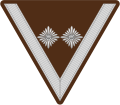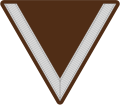
Ranks and insignia of the Reichsarbeitsdienst were paramilitary ranks used by the Reich Labour Service of Nazi Germany.

Ranks and insignia of the Reichsarbeitsdienst were paramilitary ranks used by the Reich Labour Service of Nazi Germany.
| Troop ranks [1] | Administrative ranks [1] | Medical officers ranks [1] | Female ranks | Equivalent Wehrmacht rank [2] | |
|---|---|---|---|---|---|
| Reichsarbeitsführer | - | - | - | Generalfeldmarschall | |
| Generaloberstfeldmeister (1945) | - | - | - | Generaloberst | |
| Generalfeldmeister (1945) | - | - | - | General der Waffengattung | |
| Obergeneralarbeitsführer | - | - | - | Generalleutnant | |
| Generalarbeitsführer | Generalarbeitsarzt | - | Generalmajor | ||
| Oberstarbeitsführer | Oberstamtswalter | Oberstarbeitsarzt | Maidenhauptstabsführerin | Oberst | |
| Oberarbeitsführer | Oberstabsamtswalter | Oberarbeitsarzt | Maidenoberstabsführerin | Oberstleutnant | |
| Arbeitsführer | Stabsamtswalter | Arbeitsarzt | Maidenstabsführerin | Major | |
| Oberstfeldmeister | Hauptamtswalter | Arbeitsfeldarzt | Maidenhauptführerin | Hauptmann | |
| Oberfeldmeister | Oberamtswalter | Arbeitslagerarzt | Maidenoberführerin | Oberleutnant | |
| Feldmeister | Amtswalter | - | Maidenführerin | Leutnant | |
| Unterfeldmeister | - | - | Maidenunterführerin | Stabsfeldwebel | |
| Haupttruppführer (1944) | - | - | - | Oberfeldwebel | |
| Obertruppführer | - | Jungführerin | Feldwebel | ||
| Truppführer | - | Kameradschaftsführerin | Unteroffizier | ||
| Untertruppführer | - | - | - | Unteroffiziersanwärter | |
| Hauptvormann | - | - | - | Stabsgefreiter | |
| Obervormann | - | - | - | Obergefreiter | |
| Vormann | - | - | - | Gefreiter | |
| Arbeitsmann | - | - | Arbeitsmaid | Schütze | |

| Collar insignia | Shoulder insignia | Chevrons (used in 1940) [3] | RAD rank | Translation | Heer equivalent |
|---|---|---|---|---|---|
 | | Reichsarbeitsführer | Reich labour leader | Generalfeldmarschall | |
| | Generaloberstfeldmeister | Colonel general field master | Generaloberst | ||
| | Generalfeldmeister | General field master | General der Waffengattung | ||
| | Obergeneralarbeitsführer | Senior general labour leader | Generalleutnant | ||
| | Generalarbeitsführer | General labour leader | Generalmajor | ||
 | | Oberstarbeitsführer | Colonel labour leader | Oberst | |
| | Oberarbeitsführer | Senior labour leader | Oberstleutnant | ||
| | Arbeitsführer | Labour leader | Major | ||
 | | Oberstfeldmeister | Colonel field master | Hauptmann | |
| | Oberfeldmeister | Senior field master | Oberleutnant | ||
| | Feldmeister | Field master | Leutnant | ||
| | Unterfeldmeister | Junior field master | Hauptfeldwebel | ||
 | |  | Obertruppführer | Senior troop leader | Feldwebel |
| |  | Truppführer | Troop leader | Unteroffizier | |
| |  | Untertruppführer | Junior troop leader | Unteroffiziersanwärter | |
 | |  | Hauptvormann | Head foreman | Stabsgefreiter |
| |  | Obervormann | Senior foreman | Obergefreiter | |
 | |  | Vormann | Foreman | Gefreiter |
 | | Arbeitsmann | Working man | Soldat |
| Male - rank | Male - paygrade | Male - annual salary [4] Reichsmark (RM) | Number of regular positions 1939 [5] | Female - rank | Female - paygrade | Female - annual salary [6] (RM) | Wehrmacht equivalent |
|---|---|---|---|---|---|---|---|
| Reichsarbeitsführer | RADm 1 | 24 000 | 1 | OF-10 | |||
| Obergeneralarbeitsführer | RADm 2 | 18 000 | 1 | OF-7 | |||
| Generalarbeitsführer | RADm 3 | 14 000 | 19 | OF-6 | |||
| Oberstarbeitsführer | RADm 4 | 8400-12600 | 48 | Maidenhauptstabsführerin | RADw 1 | 5500-9500 | OF-5 |
| Oberarbeitsführer | RADm 5 | 7000-9700 | 354 | Maidenoberstabsführerin | RADw 2 | 4800-8400 | OF-4 |
| Arbeitsführer | RADm 6 | 5200-8400 | 882 | Maidenstabsführerin | RADw 3 | 3800-5900 | OF-3 |
| Oberstfeldmeister | RADm 7 | 4800-7000 | 3 205 | Maidenhauptführerin | RADw 4 | 2500-4250 | OF-2 |
| Oberfeldmeister | RADm 8a | 3000-5300 | 3 669 | Maidenoberführerin | RADw 5 | 2100-3100 | OF-1 |
| Feldmeister | RADm 8b | 2400-4600 | 4 934 | Maidenführerin | RADw 6 | 1440-2200 | |
| Unterfeldmeister | RADm 9 | 2350-3500 | 7 805 | Maidenunterführerin | RADw 7 | 1200-1650 | OR-9 |
| Obertruppführer | RADm 11a | 2000-2700 | 13 576 | OR-6 | |||
| Truppführer | RADm 11b | 1140-1424,40 | 13 894 | OR-5 | |||
Mean annual pay for an industrial worker was 1,459 Reichsmarks in 1939, and for a privately employed white-collar worker 2,772 Reichsmarks. [7]